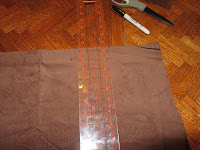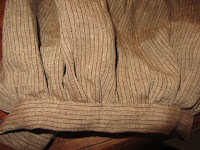 As I mentioned a little while ago, there is a pirate parade on the horizon here in Tucson--something I absolutely cannot resist. I started making plans for a pirate costume almost immediately, but those plans were a bit amorphous at first. There were the obvious things, well, thing. (Well, alright, I did it for the hat.) But beyond that, the world was, literally, my playground.
As I mentioned a little while ago, there is a pirate parade on the horizon here in Tucson--something I absolutely cannot resist. I started making plans for a pirate costume almost immediately, but those plans were a bit amorphous at first. There were the obvious things, well, thing. (Well, alright, I did it for the hat.) But beyond that, the world was, literally, my playground.Serendipity, that unpredictable but charming beast, was at work, however. There is a blog that I follow-- Multiculturalism for Steampunk -- and the charming writer of that work has initiated a challenge which I found very inspiring. Since this week's challenge is the Airship Pirate, I think Serendipity has been working over time. Her challenge caused my mind to travel down the various pathways of interest and occupation in my life until I settled on the Balkans and the Ottoman Empire for my particular sources of inspiration.
Fortunately for me, because I spend every Monday night singing the folk music of that area with the ensemble, Mzekala, I already have a great fondness for and familiarity with the Balkans. In my capacity as blog writer for Mzekala, I have already done a fair bit of research on the costumes, cultures and traditions of the Balkans. This gave me a good start on ideas for the costume, and I decided I would give my corset a little Balkan flair.

Earlier I mentioned the Ottoman Empire, and it was most certainly on my mind. During the 19th century, nationalism was on the rise all over Europe and nowhere more so than in the Balkans which were then a part of the Ottoman Empire. The Ottoman Empire was a quite the melting pot, and in some parts, it was extremely cosmopolitan. Cultural elements spread across the empire, in particular elements of fashion and ornamentation-- the fez, for instance, or the wonderful gold-work embellishments found on many garments.
That Ottom
 an presence in the Balkans gave rise to the very class of people I wanted to represent for the pirate parade: hajduks or, as I saw them called someplace, land pirates. Outlaws, rebels, heroes--these men were as diverse and hard to pin down as the Balkans themselves. They were, without doubt, deeply important to the independence movements across the Balkans, and they were most certainly the kind of colorful, romanticized figures in folk culture that pirates have become in modern popular culture. In the hajduks, I saw an opportunity to re-imagine an airship pirate who could be a heroine as well as a rogue.
an presence in the Balkans gave rise to the very class of people I wanted to represent for the pirate parade: hajduks or, as I saw them called someplace, land pirates. Outlaws, rebels, heroes--these men were as diverse and hard to pin down as the Balkans themselves. They were, without doubt, deeply important to the independence movements across the Balkans, and they were most certainly the kind of colorful, romanticized figures in folk culture that pirates have become in modern popular culture. In the hajduks, I saw an opportunity to re-imagine an airship pirate who could be a heroine as well as a rogue.Now that I had an idea for what I was doing with the corset, it was time to
 start the sewing. Well, the fun sewing. I had already tracked down, mocked-up and fitted a pattern but now I could have fun giving it that Ottoman Empire era Balkan flair. I knew I wanted to do some gold-worked arabesques on the outer fabric and hoped that I could find some pre-drafted embroidery patterns to work with. I had very little luck in this regard so I ultimately
start the sewing. Well, the fun sewing. I had already tracked down, mocked-up and fitted a pattern but now I could have fun giving it that Ottoman Empire era Balkan flair. I knew I wanted to do some gold-worked arabesques on the outer fabric and hoped that I could find some pre-drafted embroidery patterns to work with. I had very little luck in this regard so I ultimately 
Initially, I had a demented plan to make part of the embellishment look like meshing cogs and gears. I thought it would be a nicely subtle nod to steampunk. Hah. It was so subtle that they shall forever be remembered as sunbursts, not gears. Our little secret, dear readers, the "rays" mesh just like gears. Well, a costume piece is always improved by a little humor.
Once I had
 the design, it was merely a question of endurance as I couched 12 yards of gold cord across the outer surface of the corset. (A great deal of tea and many Dr. Who episodes were sacrificed for this part of the project.) Later, I'll write up the actual making of the corset but today, I wanted to feature the design elements and the inspiration process.
the design, it was merely a question of endurance as I couched 12 yards of gold cord across the outer surface of the corset. (A great deal of tea and many Dr. Who episodes were sacrificed for this part of the project.) Later, I'll write up the actual making of the corset but today, I wanted to feature the design elements and the inspiration process.If you are curious about the Balkans and th
 e Ottoman Empire, let me suggest some further reading.
e Ottoman Empire, let me suggest some further reading.Bai Ganyo: luckily for us, this book was recently translated into English. It's an excellent translation and a wonderful look at 19th Century Bulgaria culture. You can read my discussion of it here.
Black Lambs and Grey Falcons: a collection about 19th century women travelers in the Balkans, not the famous and similarly titled Black Lamb and Grey Falcon, which is also a good read.
Oriental Panorama: British Travellers in 19th Century Turkey: a book I perused while learning about hajduks. I found a copy to read in part here.
Imagined Communities: an incredible work on Nationalism and a must read for anyone interested in that topic.
And finally, here is a nice history overview of Ottoman Empire as it began to fail.
The history of both the Balkans and the Ottoman Empire is so immense that no list, especially one so short, can ever be complete, but these are a few nice places to start.
~La Cucitrice














